This Pad Thai recipe is fast and easy to make with simple, authentic ingredients in under 30 minutes! Add shrimp, chicken, or tofu for a delicious vegetarian version. Video.
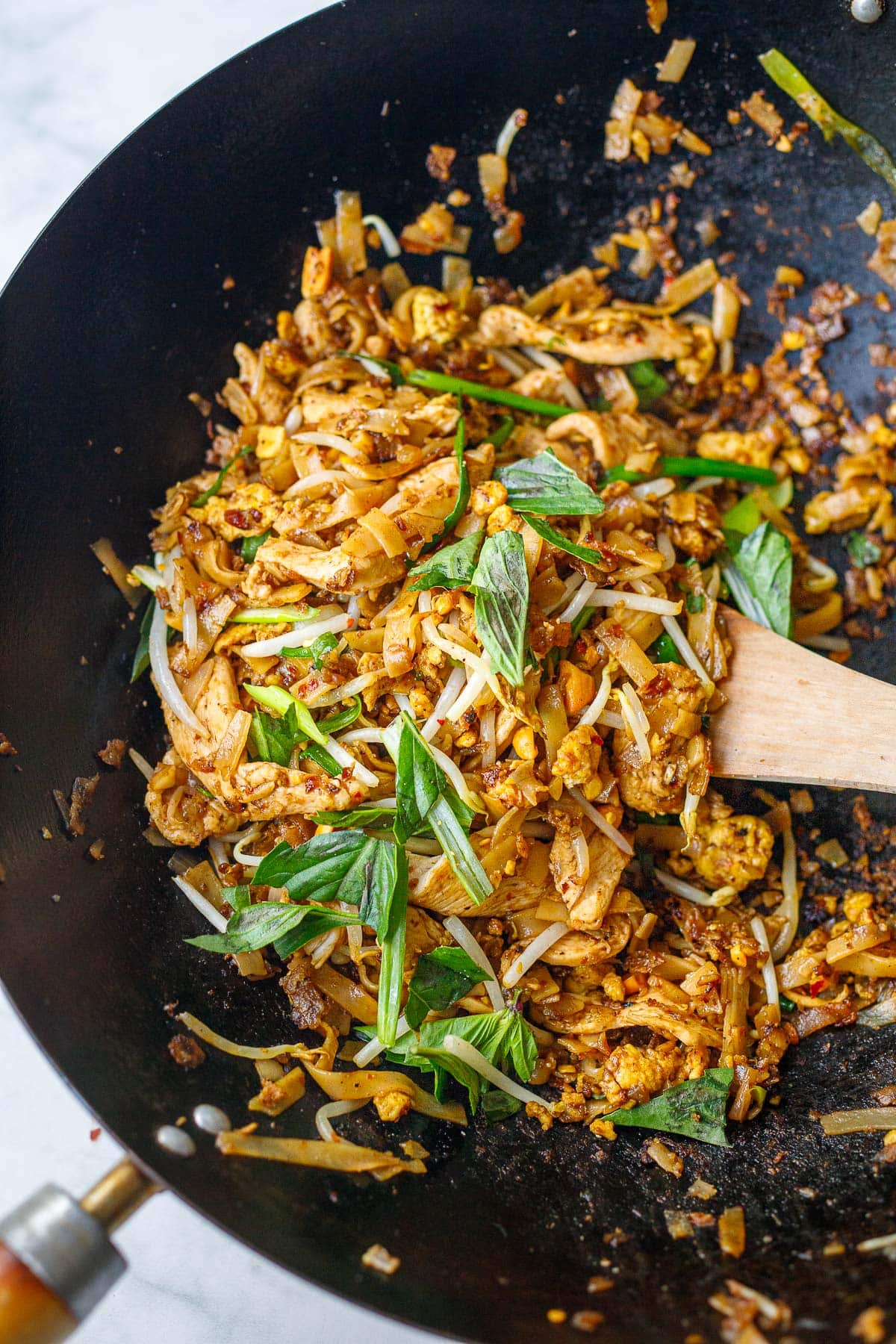
As a chef and caterer, I’ve cooked and eaten a lot of Pad Thai in my lifetime, both here and all throughout Thailand. We’ve captured the authentic flavor you’ll find in Bangkok while keeping the ingredients simple and the cooking fast and easy.
I may be biased, but I think this is the best Pad Thai recipe around—not overly sweet like many Americanized versions. You’ll find no ketchup or peanut butter in this recipe. But don’t take my word for it; just read all our great reviews!
But first, What is Pad Thai?
Pad Thai is a popular stir-fried noodle dish from Thailand made with rice noodles, shallot, garlic, scrambled eggs, and a protein, typically chicken or shrimp, in a flavorful, tangy, umami Pad Thai Sauce. It’s served with fresh bean sprouts, crushed peanuts, scallions and lime.
Why this Pad Thai Recipe is the Best!
- Balanced Flavor. Pad Thai sauce is a delicate balance between umami, sourness, and sweetness. Most American versions are way too sweet; this one is just right.
- It’s adaptable! This recipe can be made with chicken, shrimp, tofu and /or veggies! Gluten-free, vegetarian and vegan-adaptable.
- Quick and Easy– Once the ingredients are prepped, this takes 15 minutes of cooking time!
- Simple Ingredients. These accessible ingredients can be found in most grocery stores.
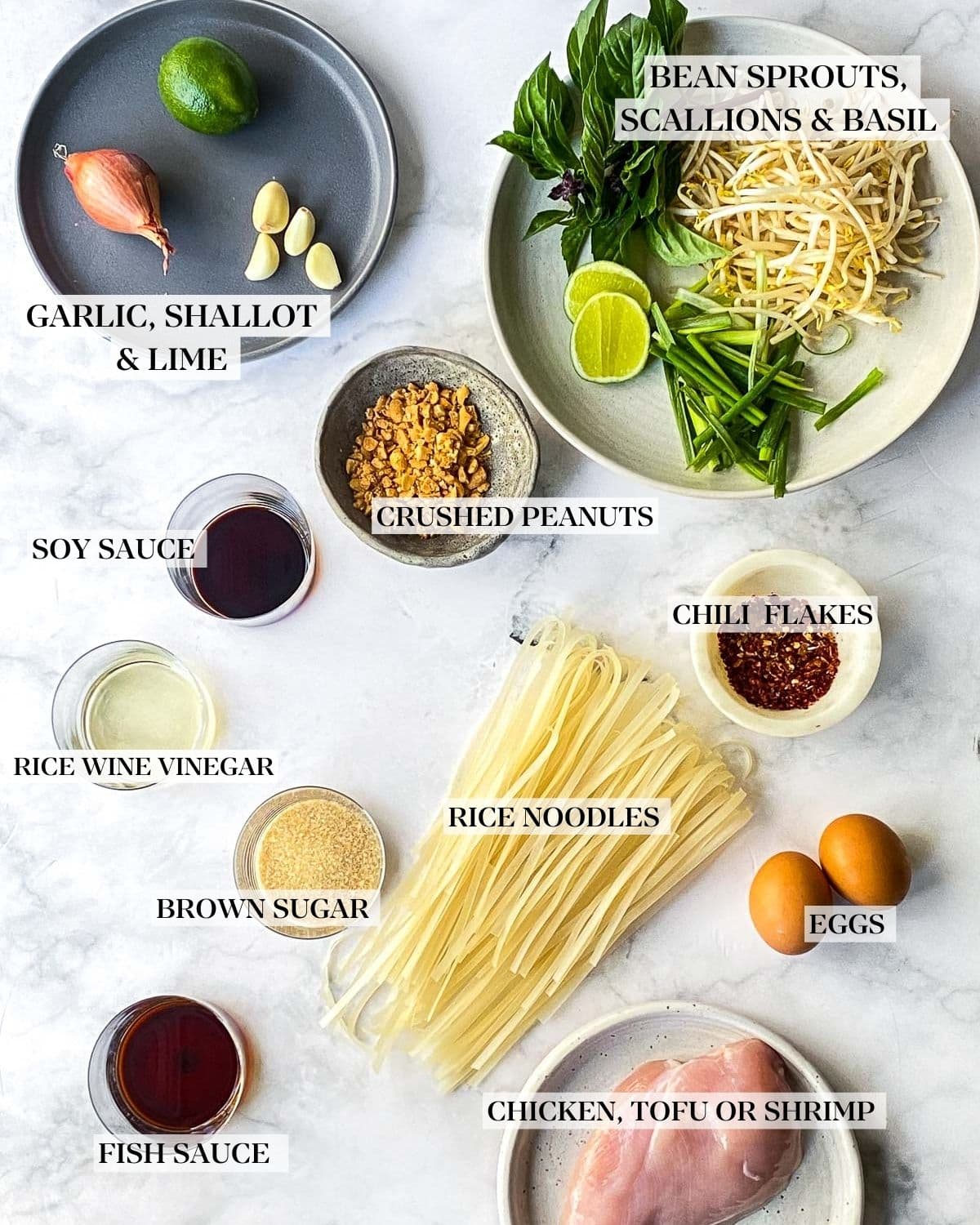
Pad Thai Ingredients
- Rice Noodles: Pad Thai is typically made with noodles called “rice stick”, which are rice noodles that are about 1/4 inch wide. Some brands are better than others- many fall apart when stir-frying. I have had the best luck with Thai Kitchen rice noodles. Make sure to soak the noodles, rather than boil, to prevent breaking.
- Protein: Add thinly sliced chicken breast, shrimp, or crispy Tofu, or leave out the protein and add stir-fried veggies. Extra firm tofu works best.
- Eggs: Traditional pad thai has scrambled eggs, vegans can leave this out.
- Garlic cloves and shallots: Shallots really elevate Pad Thai. I highly recommend shallots over onions if possible. Some versions use ginger, but in Thailand, they generally don’t.
- Fresh Lime Juice: adds acidity.
- Garnishes: The garnishes make Pad Thai, adding texture and flavor. Sliced green onions, crushed roasted peanuts, fresh bean sprouts, Thai chili flakes and lime wedges and if available, Thai basil, all elevate!
Pad Thai Sauce Ingredients
The secret to the best Pad Thai Sauce is the perfect balance of salty, sweet and sour. Our sauce has delicious umami and depth, while not being overly sweet with a lovely tang. Letting the sauce caramelize in the wok for just a few seconds, adds a lovely smokiness.
- Fish Sauce – Fish Sauce can vary in degrees of saltiness from brand to brand. I like Red Boat Fish sauce, or Thai Kitchen Fish Sauce (found at most grocery stores) best for this recipe. (*Vegans can sub our vegan fish sauce and soy sauce.) If you are new to fish sauce, keep in mind, it has a little “funk” to it. You can start off lighter and replace the rest with soy sauce.
- Tamarind Water or Rice Wine Vinegar – authentic Pad Thai is made with tamarind water and lime juice to give it the sour component, but feel free to use Rice Wine Vinegar and lime to keep things simple here. See recipe notes for using tamarind.
- Sugar – In Thailand, it is traditional to use palm sugar but we use brown sugar, coconut sugar or regular cane sugar to add sweetness. Note: Do not be tempted to cut back on the sugar, the Pad Thai will be too sour.
- Soy Sauce – adding a little soy sauce adds even more depth. You can also use gluten-free liquid aminos!
How to make Pad Thai (easy Instructions)
Step 1: Soak the rice noodles. Pour boiling water over the rice noodles let them soak until they are soft and pliable (about 5-6 minutes) but not overly soft; drain.
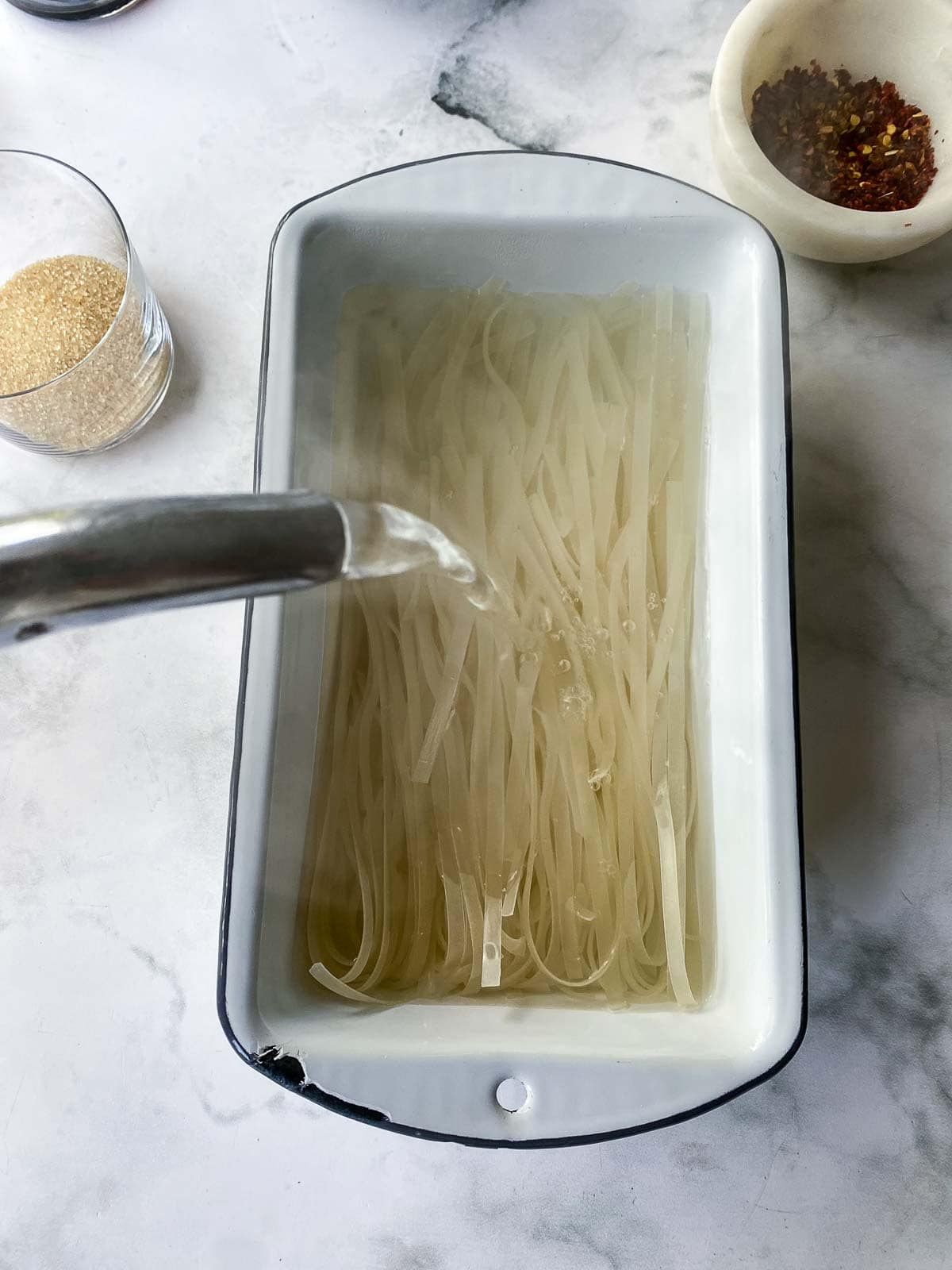
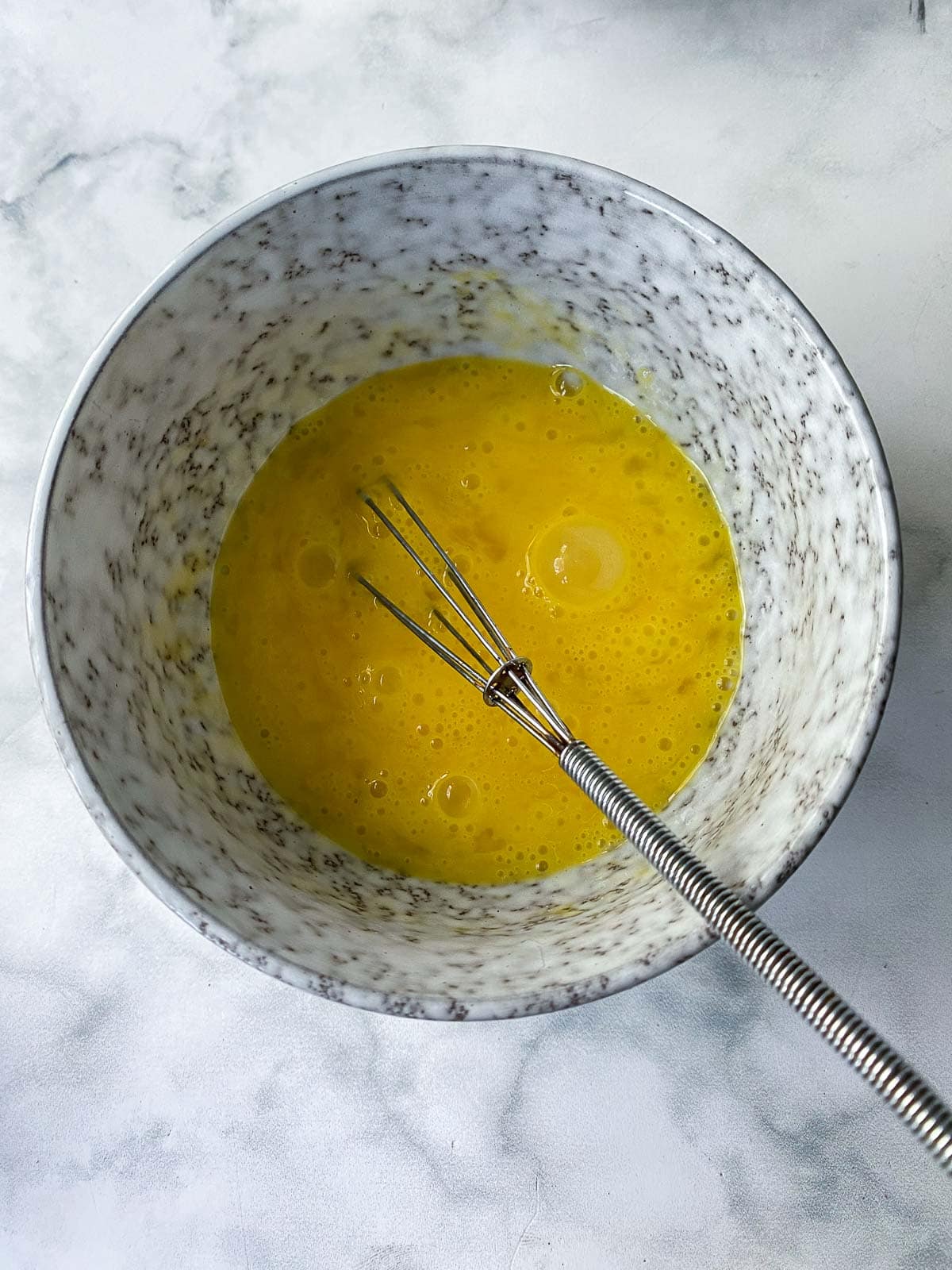
Step 2: Whisk the Eggs. Whisk the eggs in a medium bowl with a pinch of salt. Set aside by the stove.
Step 3: How to make Pad Thai Sauce. Whisk the pad thai sauce ingredients together in a small bowl- keeping in mind, there is a delicate balance between salty, sour and sweet, so if you alter one ingredient, you may need to adjust the others. Make sure the sugar completely dissolves.
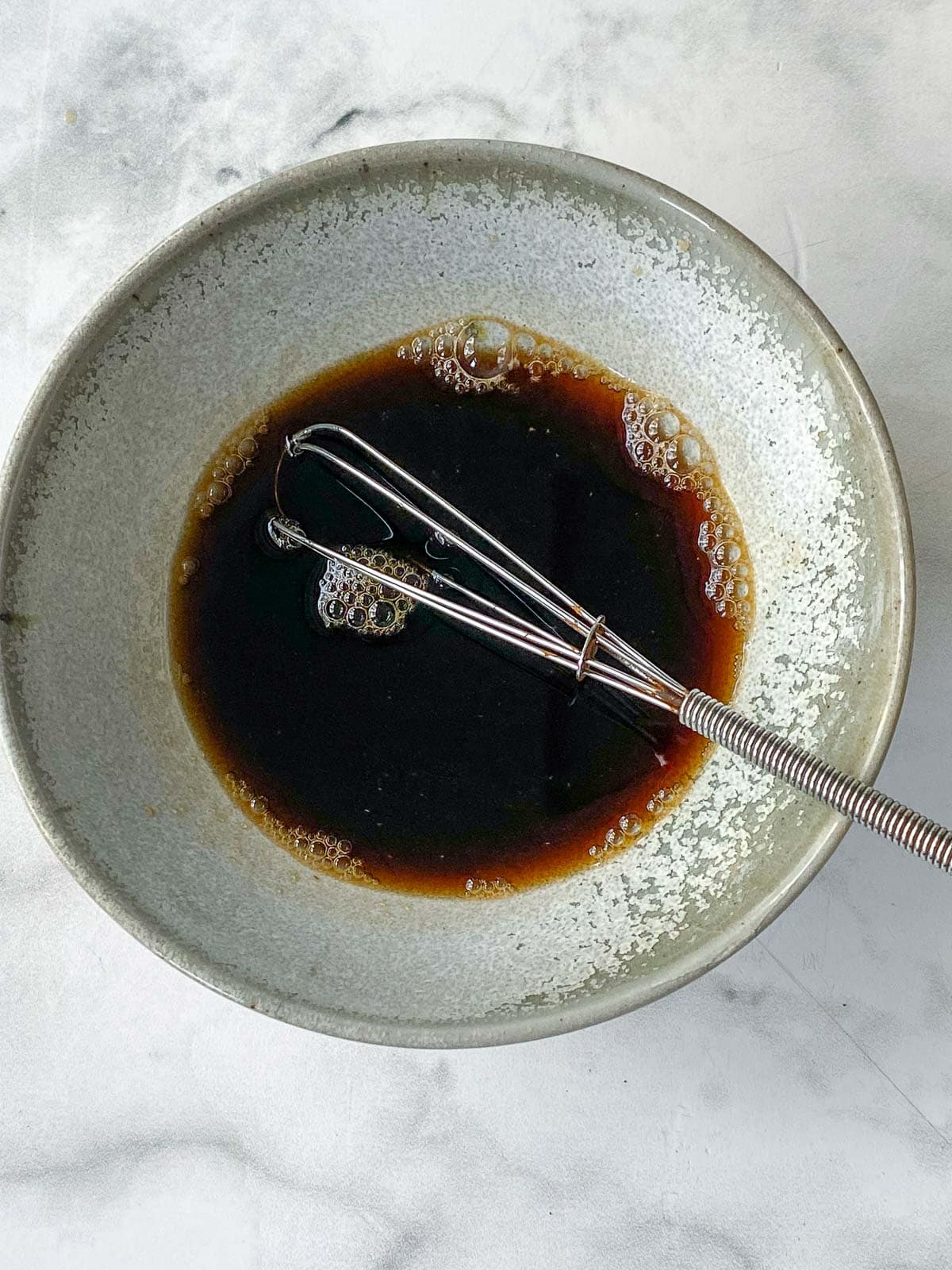
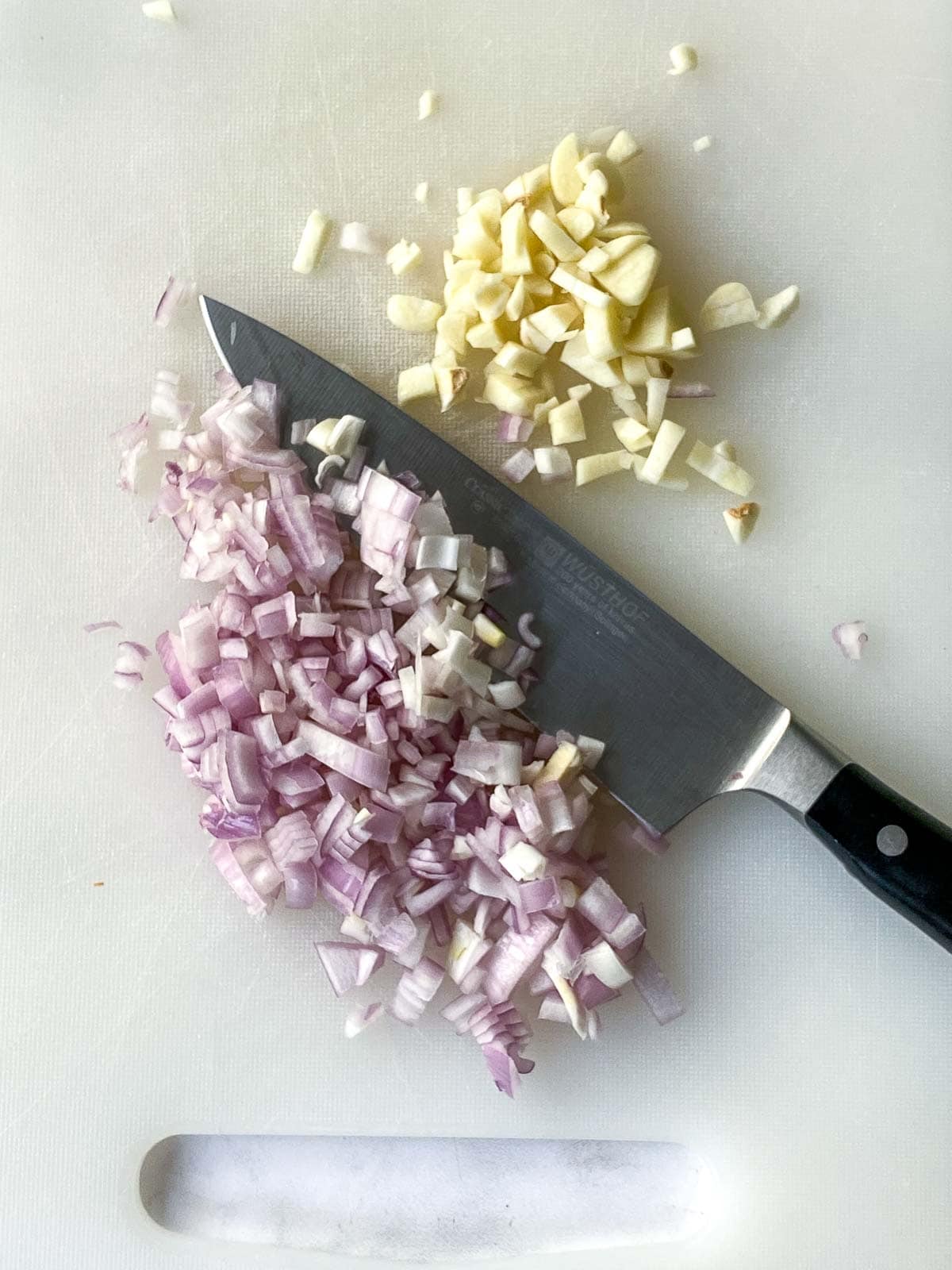
Step 4: Prep the Protein & Veggies. Chop the shallot and garlic finely and set aside. Slice chicken thinly across the grain (or peel and devein shrimp). If adding veggies, chop or slice them small, so they cook quickly in the wok.
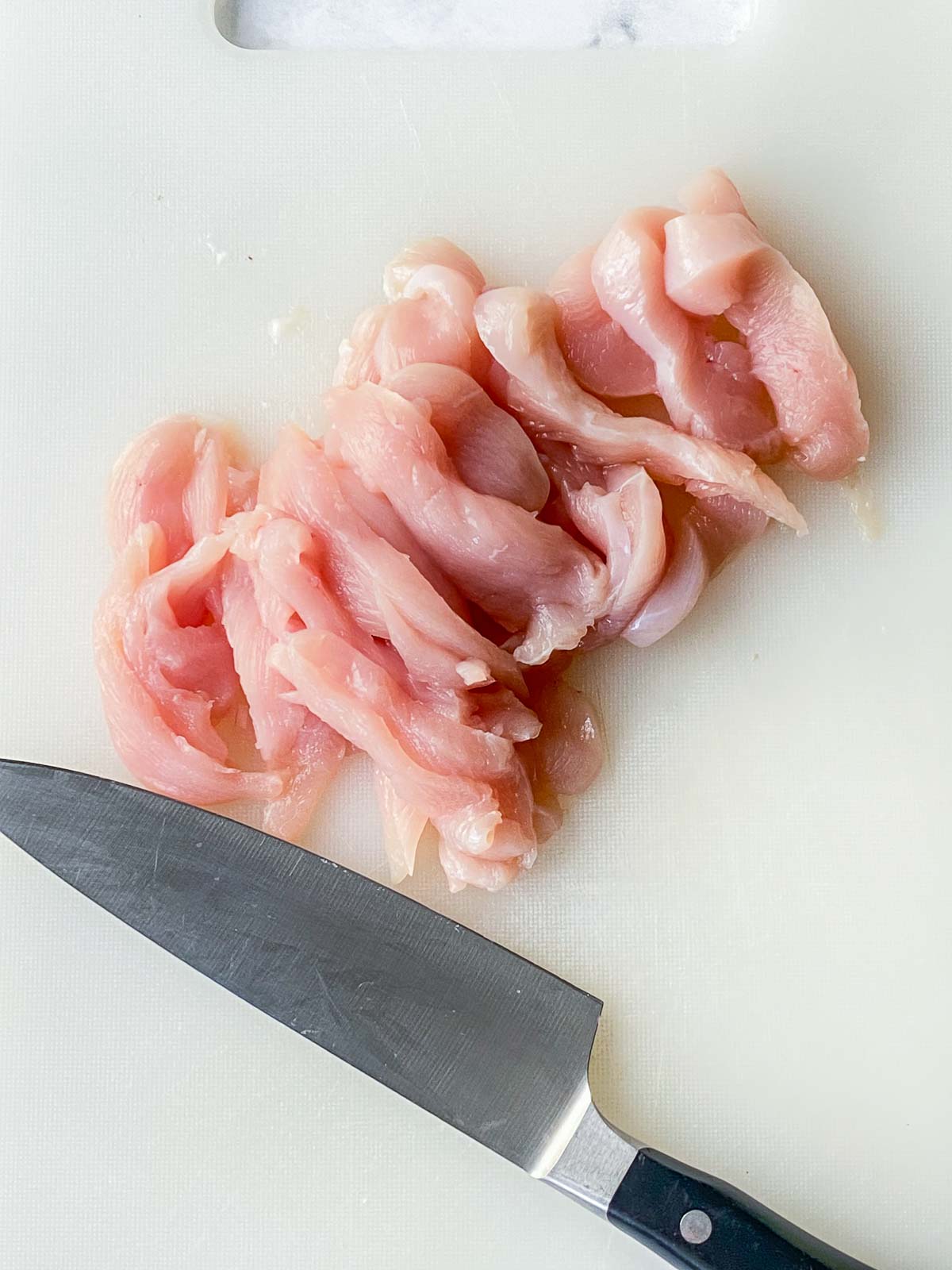
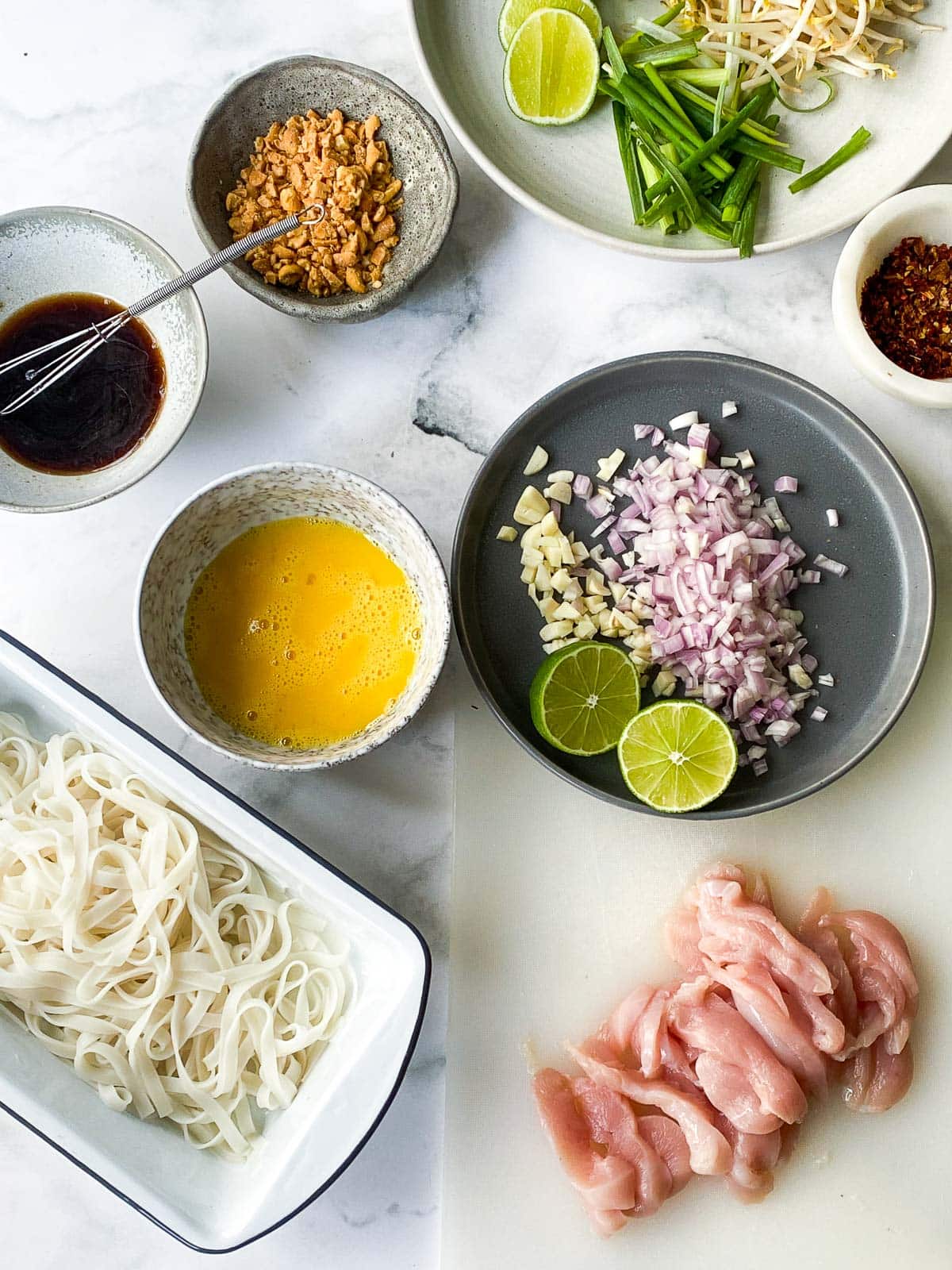
Step 5: Prep all your garnishes and have everything ready to go by the stove, keeping in mind the stir fry part will go quickly!
Step 6: Stir Fry! Season the protein with salt and pepper, and stir fry in a carbon steel wok until just cooked through and set it aside. If adding veggies, stir-fry these now and set aside as well.
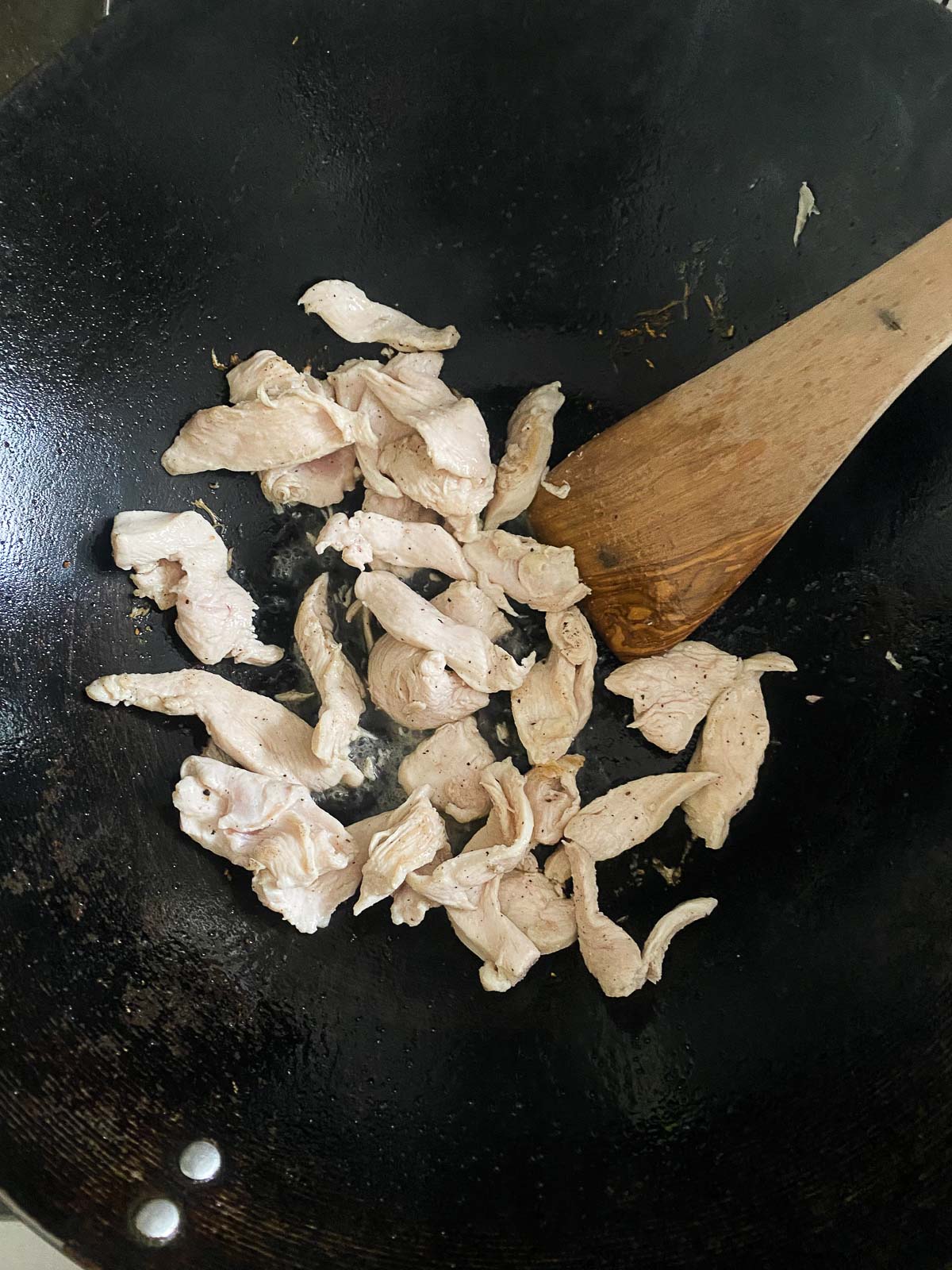
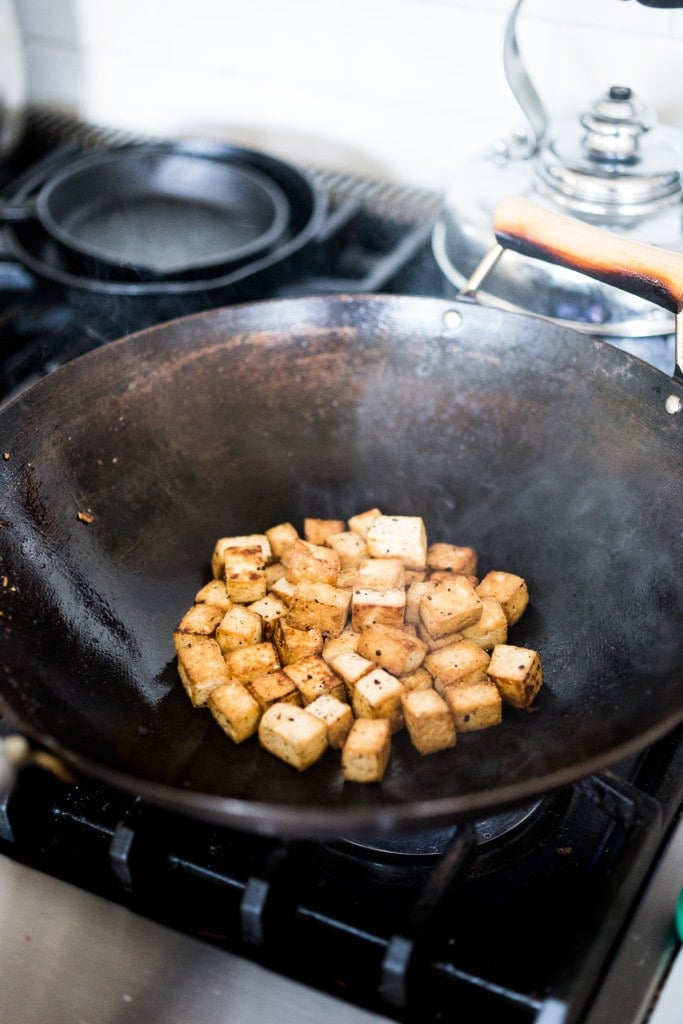
Add more oil to the wok and stir fry the garlic and shallots for just a couple minutes, scoot them over, add more oil if needed, and add the whisked the eggs, scrambling and breaking to bits.
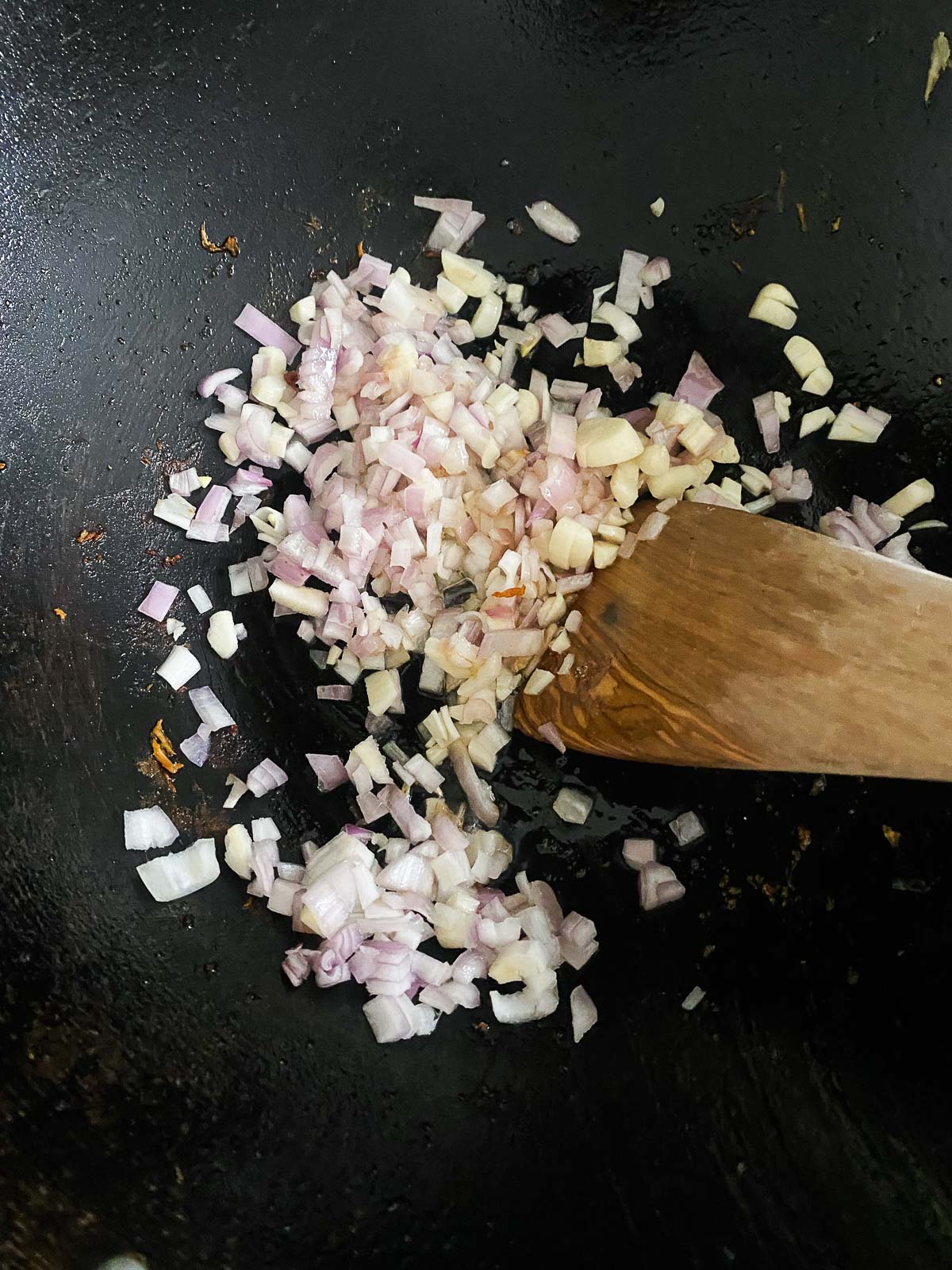
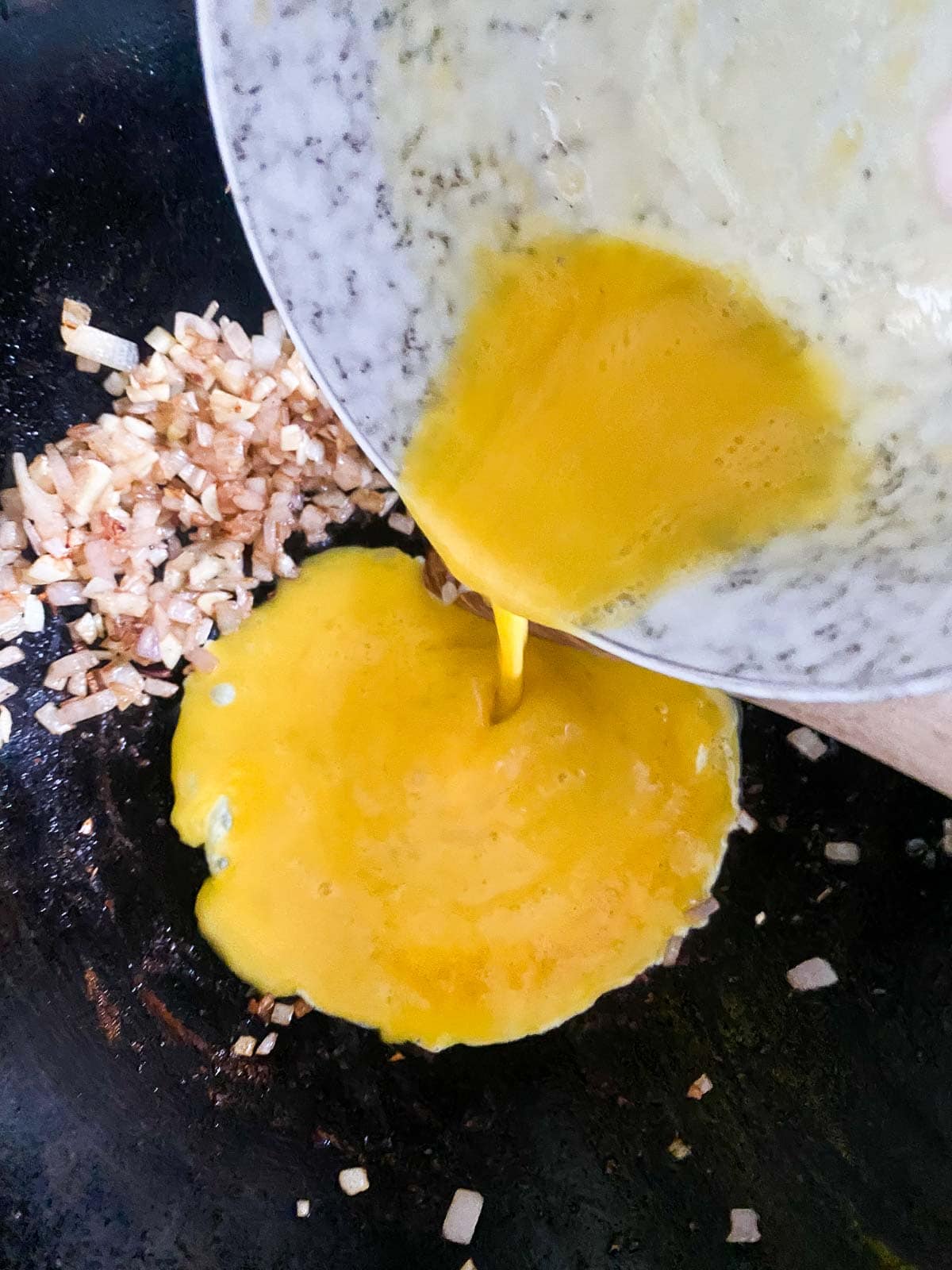
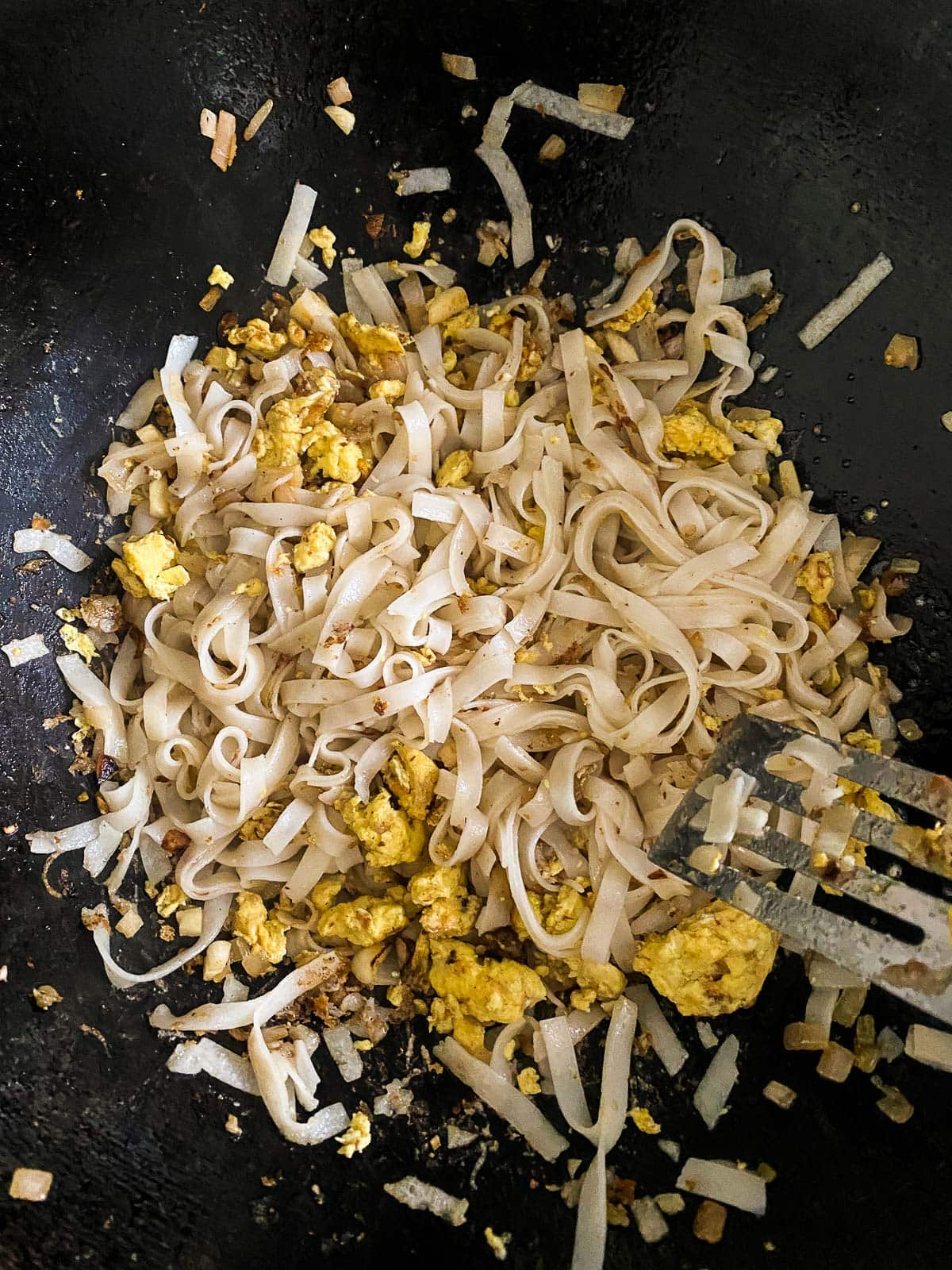
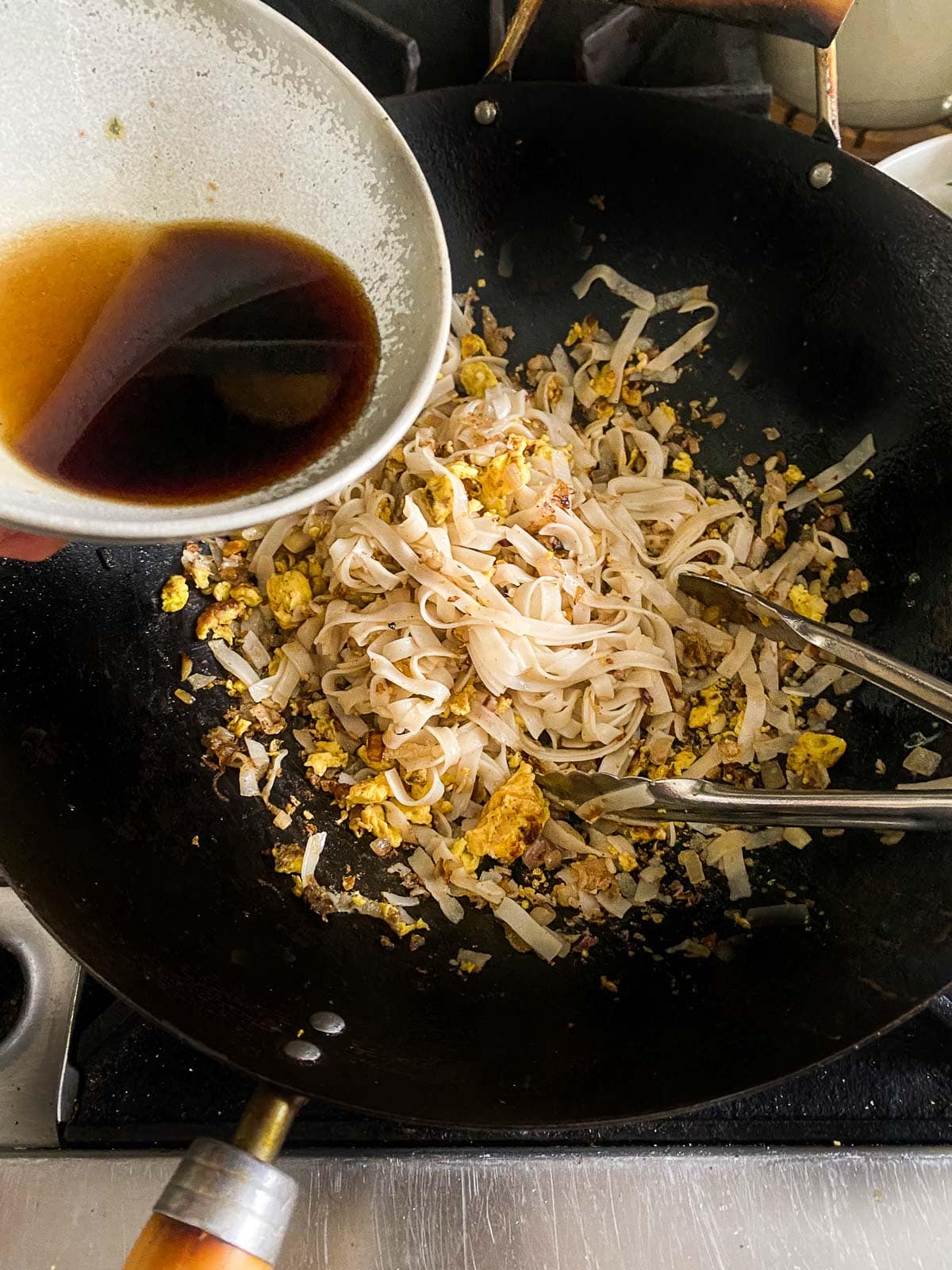
Scoot the eggs over and add more oil and stir fry the noodles, letting the noodles get a little crispy! Turn your hood on and pour in the Pad Thai Sauce. Let the sauce caramelize for 30 seconds, until you smell the sugar caramelizing. This will add great flavor!
Add back in the cooked protein and veggies, with some of the bean sprouts and scallions. Add a squeeze of lime.
*Taste and adjust salt, lime or sugar to taste. Find the perfect balance. See FAQ’s for troubleshooting the flavors.
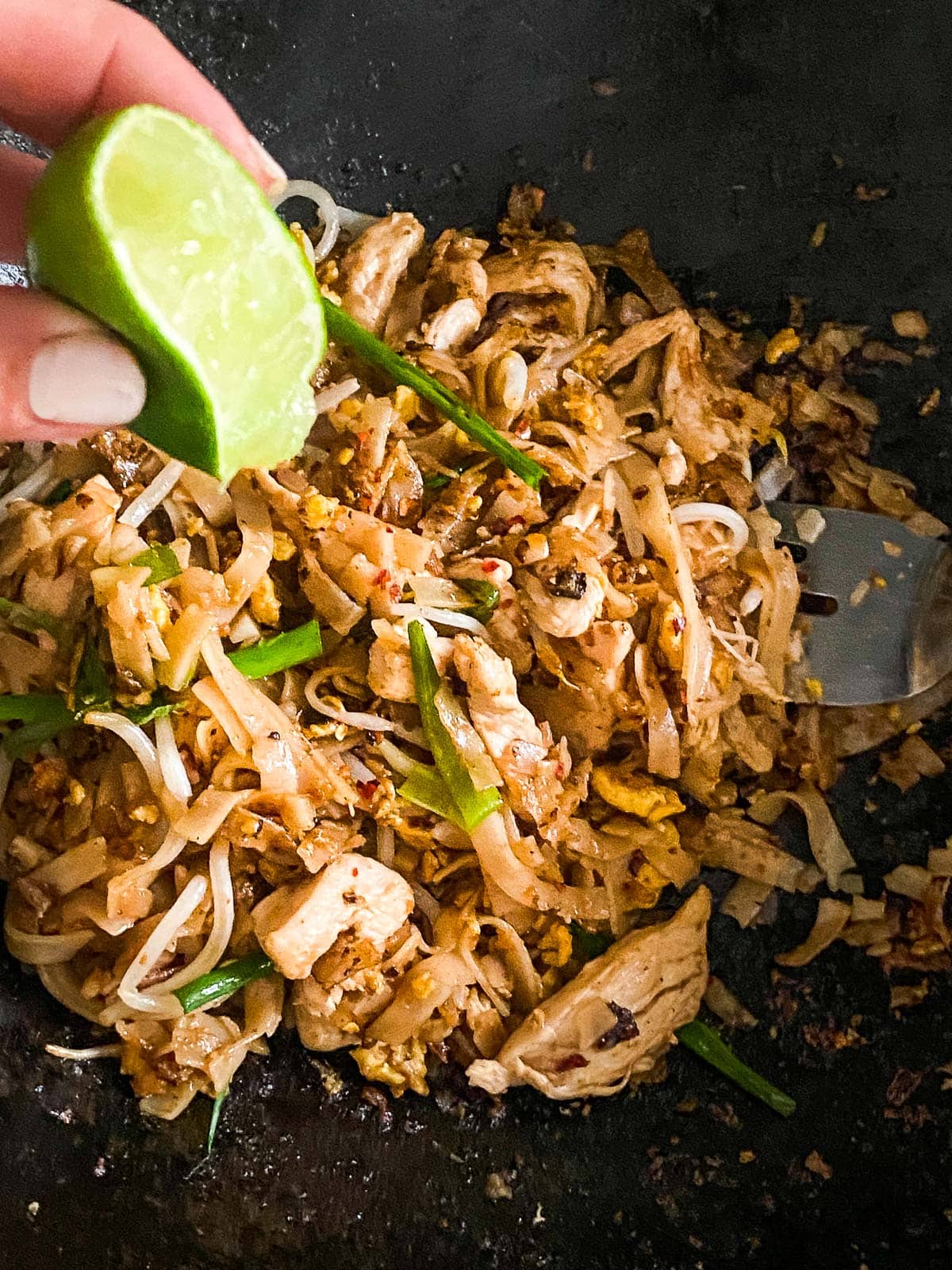
Step 7: Serve. Divide between 2-3 bowls and garnish with fresh bean sprouts, lime, wedge, crushed peanuts, chili flakes, scallions and basil. For extra heat, serve it with our chili garlic sauce!
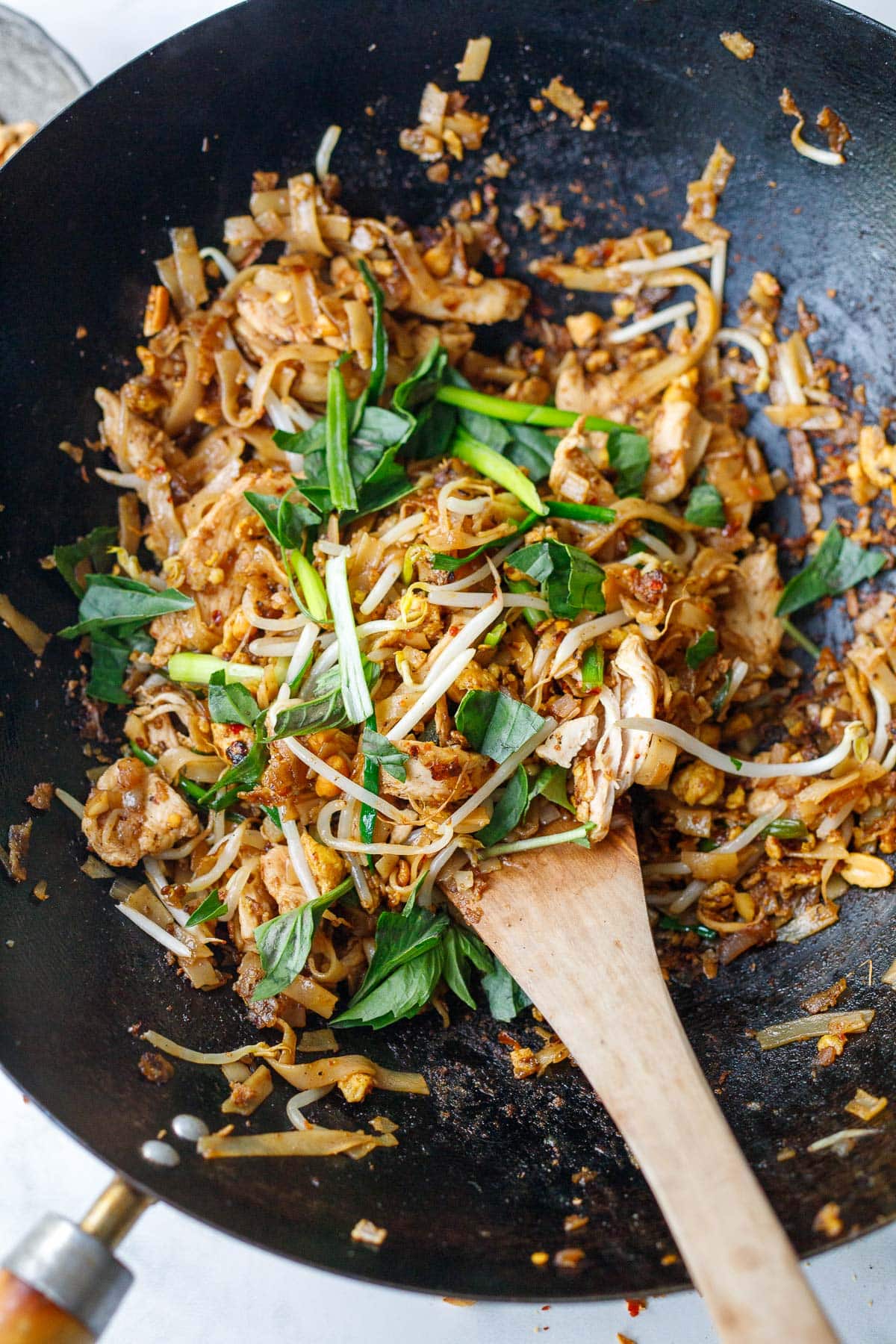
Pad Thai Noodle Tips
- Read the whole recipe through before you give it a go.
- Prep everything first, then place it near the stove. Cooking goes very fast here!
- Cut chicken very thinly to cut down on cooking time. Remember to cut across the grain, into ⅛ -¼ thin strips about two inches long.
- To lower calories, poach the chicken in a little salted water, until cooked through which just takes a couple of minutes. Then set it aside.
- Use shallot. Shallot adds so much flavor here- much more so than onion.
- Crispy noodles. Crisp up the rice noodles in the pan before adding the sauce.
- Let the Pad Thai sauce caramelize in the wok, before turning off the heat. This is the secret to the best flavor- a smoky sweetness we all crave!
Pad Thai Don’ts
- Please do not add ketchup or peanut butter. This is not authentic and takes away from the dish.
- Don’t use white vinegar instead of rice vinegar. White vinegar tastes way more acidic and it will be overly sour.
- Don’t skip the sweetener. you will lose the balance of the dish. You will end up with fishy, overly sour, salty Pad Thai that tastes terrible. TRUST ME.
- Don’t make too big of a batch. The noodles are stir-fried. You want the noodles to get slightly crispy in the pan, and the sugars to caramelize, giving them that incredible smoky flavor- this is difficult to achieve if making huge batches.
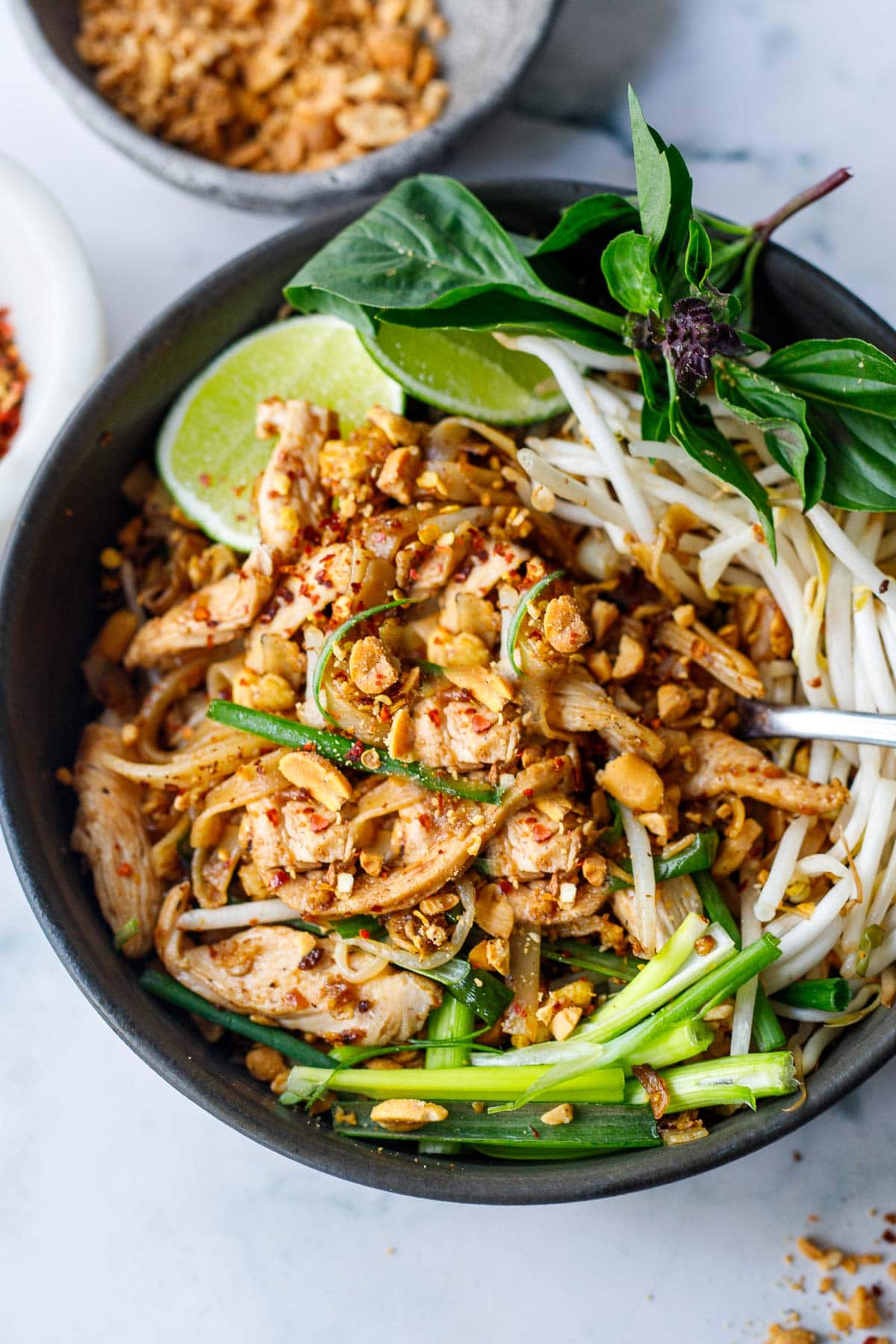
Serving Pad Thai Noodles
- Serve Pad Thai with lime wedges.
- Add fresh bean sprouts.
- Sprinkle with crushed roasted peanuts (or try this amazing Peanut Chili Crunch!)
- Add chopped scallions or Thai basil.
- Serve with Thai chili flakes, sriracha or chili paste for extra heat.
Storing Homemade Pad Thai
Pad Thai is best served right after it is cooked. Leftovers will last up to four days in an airtight container in the refrigerator. Reheat pad Thai in a skillet or wok, lightly stir frying.
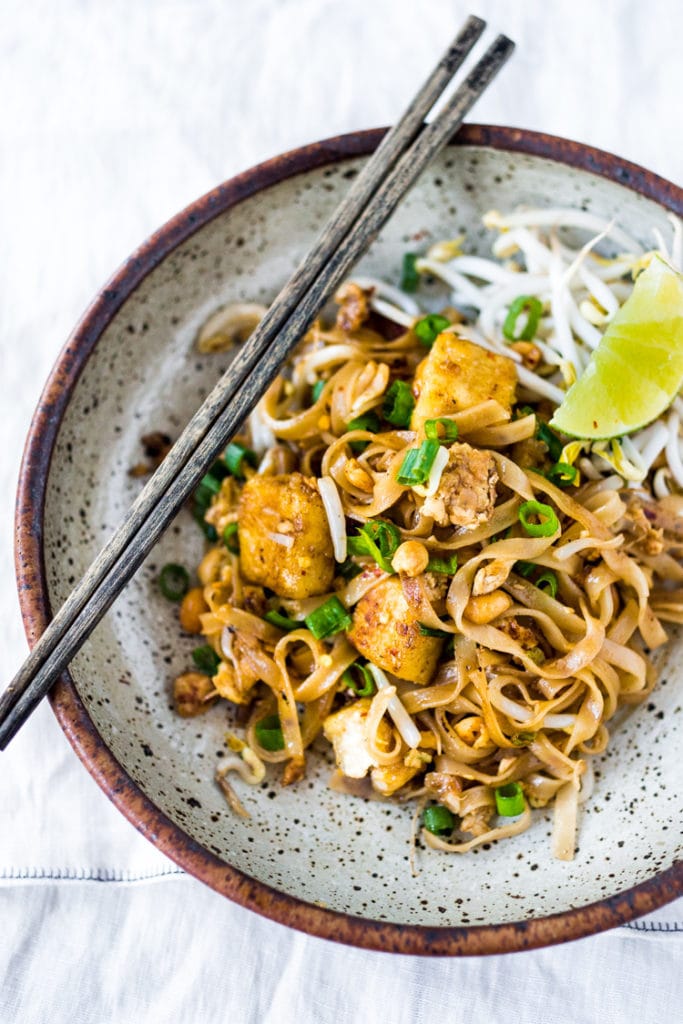
Pad Thai Recipe FAQs
Yes, Pad Thai can easily be made vegan. Use vegan fish sauce or soy sauce and crispy tofu as the protein, and leave out the eggs.
The secret to the best Pad Thai is not overcooking the rice noodles, using a very hot wok, cooking in smaller batches so rice noodles can caramelize, and having the perfect balance of flavors- not too sweet, not too sour, and not too salty.
Peanut oil adds the best flavor, while avocado and coconut oil both have a high smoke point. Both work well here. Any neutral high heat oil will work.
Any quick-cooking vegetables that can be cooked in a wok can be added to Pad Thai- asparagus, green beans, matchstick carrots, bell pepper and bok choy to name a few. Feel free to add steamed broccoli too!
Try adding a little more brown sugar and vinegar to balance it.
Add a little more brown sugar to balance it. White vinegar will do this- so always use rice wine vinegar, tamarind water or lime, which are all less acidic.
Add more acid ( rice vinegar, tamarind water or lime juice) to balance it.
What to serve with Pad Thai!
I hope that after you make this, you’ll think this is the best Pad Thai recipe you’ve ever had too! 😉 Haha! Let me know in the comments below! 🙂 Here are more of my favorite Fast, Easy Dinner Ideas!
Happy weekend.
xoxoxo
PS. It is my hope that through cooking, we not only learn new ingredients and techniques but also learn more about the culture and people from which the food we make originates. Cooking can be a way of celebrating all our unique and beautiful differences. I’d like to believe expanding our repertoire in the kitchen can also expand our hearts.
More Favorite Thai Noodle Dishes!
Love Thai Cuisine? Try…
- 33+ Easy Thai Recipes!
- Authentic Tom Kha Gai (Thai Coconut Chicken Soup)
- 30-Minute Thai Green Curry
- Thai Larb Salad
You may also love this Malaysian Char Kway Teow or Chickpea Curry!
More from Feasting At Home
How to make Pad Thai Noodles | Video
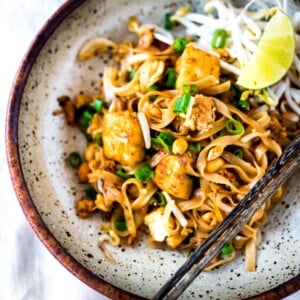
Easy Pad Thai (Chicken, Tofu or Shrimp)
- Prep Time: 15 mins
- Cook Time: 15 mins
- Total Time: 30 minutes
- Yield: 2
- Category: Main
- Method: stir-fried
- Cuisine: Thai
- Diet: Vegetarian
Description
An easy, 30-minute recipe for Pad Thai made with rice noodles, your choice of chicken, shrimp or tofu, scrambled eggs, and an incredible “not too sweet” Pad Thai Sauce. Makes 2 large servings. Watch the video!
Ingredients
- 4 ounces rice noodles
- 3 tablespoons peanut oil, divided ( or use avocado oil, or coconut oil)
- 8 ounces chicken breast, tofu or prawns (peeled and deveined)
- salt and pepper to taste
- 1 large shallot, finely diced (much better than onion here)
- 4 fat garlic cloves, roughly chopped
- 2 eggs, whisked with a fork with a generous 3-finger pinch salt if vegan, leave it out)
- 1 lime
- 1 1/2 cups bean sprouts
Pad Thai Sauce:
- 3 tablespoons fish sauce (see notes- or use vegan fish sauce)
- 3 tablespoons brown sugar (or coconut sugar, palm sugar, or regular sugar) see notes
- 3 tablespoons of rice wine vinegar (or tamarind water– see notes) do not sub white vinegar, it will be too sour.
- 2 teaspoons soy sauce (or GF liquid aminos like Braggs)
Garnish:
- lime wedges, fresh bean sprouts, chili flakes, chopped scallions, roasted peanuts, Thai basil
Instructions
- Soak the rice noodles. Place rice noodles in a shallow pan and cover with boiling water for 4-7 minutes, stirring occasionally (so they don’t stick together) until al dente; drain, rinse with cold water to stop cooking. They don’t have to be totally soft, just bendy and pliable.
- Whisk the two eggs in a bowl with a fork and add a generous, 3-finger pinch of salt. Set aside.
- Make the Pad Thai Sauce: whisk fish sauce, rice vinegar, brown sugar and soy sauce. (see notes) in a small bowl. Set aside.
- Prep the protein. Chicken: slice chicken into very thin strips and season with salt and pepper. Crispy Tofu: Blot tofu with paper towels pressing down firmly. Cut tofu into ¾ inch cubes, sprinkle with salt and pepper, and for extra crispy, dredge in a little corn starch. Shrimp: season with salt and pepper.
- Cook the protein: Heat 1 tablespoon oil in a large saucepan or wok, over medium-high heat. Sear the seasoned chicken, shrimp or tofu until cooked through. Set aside,
- Stir Fry: Gather your chopped shallots and garlic, whisked eggs, cooked noodles, cooked protein and Pad Thai Sauce around the stove. Heat a little more oil in the wok over medium heat, add shallot & garlic and stir fry 2-3 minutes. Scoot the shallot mixture to the side, add more oil, and pour in the eggs. Scramble and break them apart into little bits, and move them to the side. Add more oil, and the noodles, stirfry 2-3 minutes until noodles are soft and pliable and even a little crispy.
- Pour in the Pad Thai Sauce (turn hood on) stir everything together and cook 1-2 minute, then add the cooked protein and stirfry for a few more minutes. Just as you start to smell the sugar carmelizing, you are there! Squeeze with a little lime juice. Turn off heat.
- Taste. Adjust salt, lime, heat and sweetness to your liking; add salt, or soy sauce for more depth if you like, a squeeze of lime juice, chili flakes, or a pinch of sugar to taste.
- Toss in 1/2 the bean sprouts and roasted peanuts (or serve on the side) and sprinkle with chili flakes and scallions. Give one more toss and serve immediately. Divide among two plates.
- Garnish with more bean sprouts, fresh scallions, cilantro or basil, chili flakes, lime wedges and roasted crushed peanuts. Or make this Peanut Chili Crunch!
Equipment
Notes
Fish Sauce: If you are not accustomed to fish sauce, or are using a brand you haven’t tried before (some are fishier than others) feel free to go lighter on the fish sauce– like 2 tablespoons. If going with less, replace it with soy sauce.
Poach the chicken. An easy way to cut back on the oil in the recipe is to poach the thinly sliced chicken breast in a little salted water, or broth for a few minutes, until cooked through. Drain and set aside. The thinner you slice the chicken the faster it will cook.
Tamarind: If using tamarind paste (instead of rice vinegar) make tamarind “water” by mixing 1 tablespoon tamarind paste with 2 1/2 tablespoons hot water. If using tamarind “concentrate” mix 1-2 teaspoons with 2 1/2 tablespoons water. Use tamarind water in place of the vinegar. Using tamarind is more authentic but not everyone has access to it. Tamarind is extremely sour so if unfamiliar, go light. You can always add more lime to taste.
Nutrition
- Serving Size: 1 ½ cups
- Calories: 409
- Sugar: 14.3 g
- Sodium: 1134 mg
- Fat: 14.2 g
- Saturated Fat: 2.1 g
- Carbohydrates: 47.4 g
- Fiber: 1.1 g
- Protein: 20.5 g
- Cholesterol: 165.4 mg
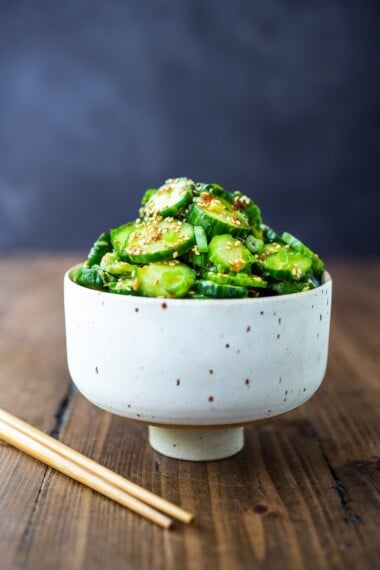
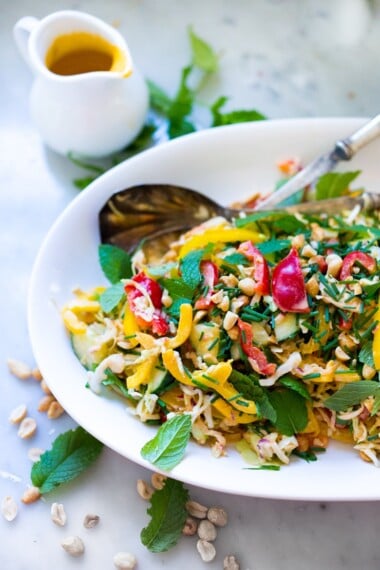
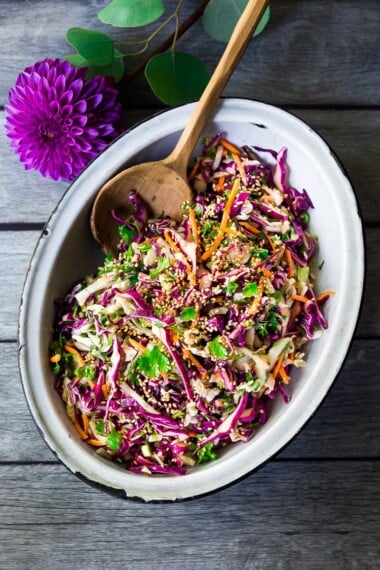
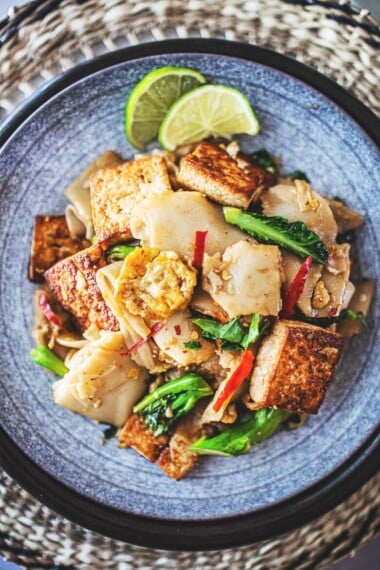
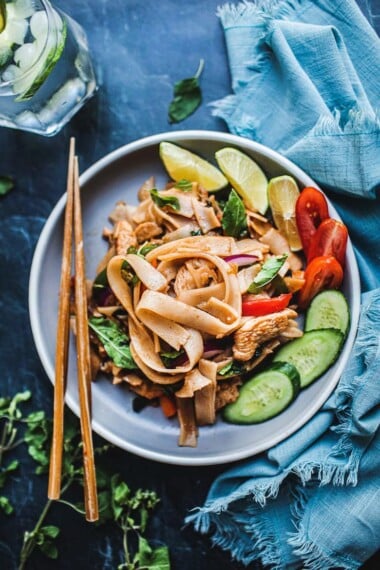
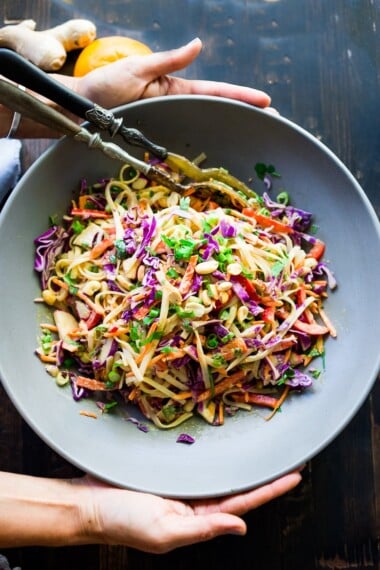
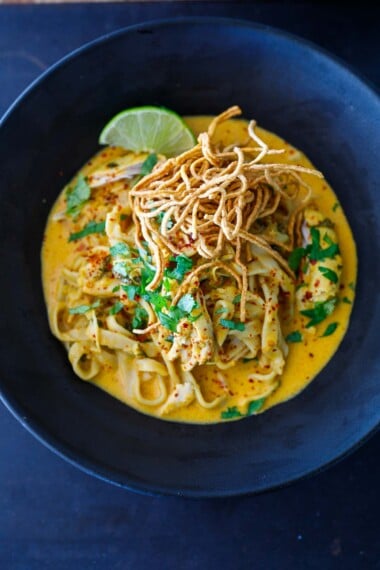
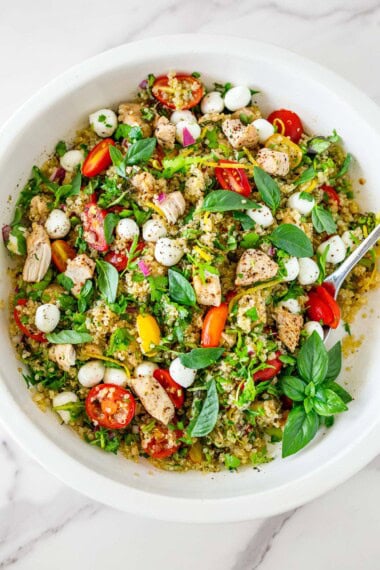
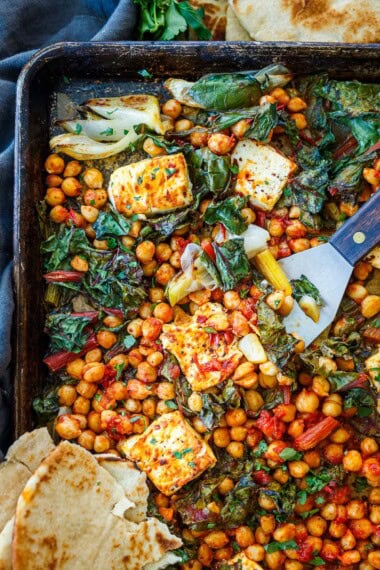
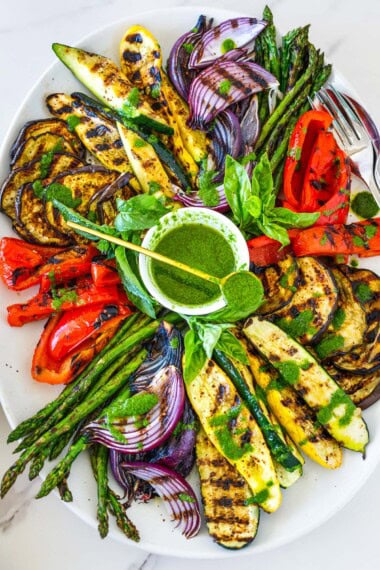

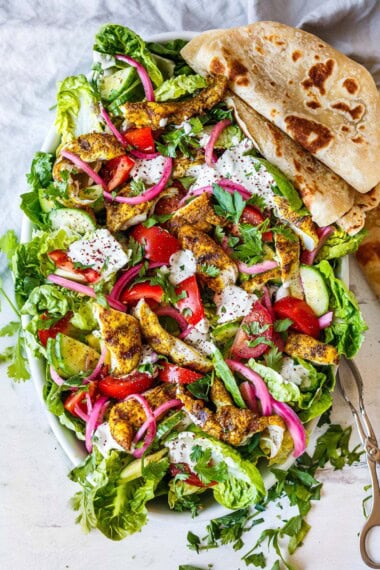

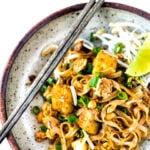
This was the first time making pad thai. This recipe was so easy and it tastes so good. I think next time i will try it with the tamarind paste.
Thank you!
Hi Alan, sorry this didn’t work for you. Did you use 4 ounces of Dry Pasta? Or cooked?
This was so good! It will be joining the rotation of family favourites often.
(While I’ll try shallots & fish sauce in the future, the yellow & green onions and oyster sauce I already had worked well.)
Great! I added some stir fry veg (carrots and snap peas) since I forgot my tofu, and that worked well. I’m always nervous trying new recipes, but this was amazing as written and I doubt I’ll make any changes to the base when I make it again. I used your vegan fish sauce recipe too! Definitely want to try with tamarind once I can get ahold of some.
Hello! I’m making this for dinner tonight, will let you know how it goes. I have two ingredient swaps, simply because they’re what I have on hand. Swap #1 – ginger-garlic paste in place of the ginger and garlic. Swap #2 – brown rice pad thai noodles. Fingers crossed that they both work out! Wish me luck, LOL
Good luck- seems like good replacements!
awesome recipe. it is light and flavourful. I’m looking forward to experimenting with the sauce.
Made this for tonight’s dinner. It was a hit! ‘Even better than the one we always have in our usual Thai restaurant. I can see this being requested by the family in the coming weeks.
Followed from A to Z.
Amazing taste. Didn’t have a wok but still working well.
A must have in your recipe book!
Cheers from Berlin.
Amazing! My entire family enjoyed this last night (7 & 10 year old included!). My husband has the luxury of dining out for lunch for business daily and mentioned that your recipe was just a great, if not better, than one of his favorite restaurants! Thanks so much for an amazing recipe!
Great to hear!
Yikes! 1063mg sodium per serving -my cardiologist would have a heart attack! Any way to reduce the sodium without losing too much taste?
The fish sauce is fairly salty, you could try cutting back a little?
Finished cooking and eaten for dinner tonight – hubby said it’s restaurant quality! Next time, I will cut down on the fish sauce, as it was quite prominent and too salty for me (I have a very low salt tolerance due to my low-salt diet). I added sautéed bean sprouts, snow peas and spring onions to increase the veggie content and peanut butter as others suggested. Yummy!
Sorry about that. Did you change any of the proportions? What kind of fish sauce did you use and did you happen to Tamari soy sauce? Just curious.
The flavor was amazing. I wish it was a little saucier so next time
I’ll double the sauce mixture.
This is the best pad Thai I’ve had and it was so easy to make! Thank you so much!
Yummy and easy!
Really good, my daughter and I enjoyed this dish!
We didn’t have peanuts so I added peanut butter while it cooked. The melted peanut butter tossed throughout really gave it that extra WHOOMP! THERE IT IS!
My first time using rice noodles, fish sauce and rice vinegar. Was apprehensive about the fish sauce.. but as mentioned in the recipe, it became less fishy the more it cooked…
Good stuff, will add this recipe to my book.
Thank u so much for sharing this with all of us.
Always looking for new and tasty recipes and alot of sites charge a fee to access.
That’s one luxury I can’t budget in.
So a high five and heartfelt thank u!
Psalm 20:4 ESV
May he grant you your heart’s desire and fulfill all your plans!
“Cooking is like love. It should be entered into with abandon or not at all.”
– Harriet Van Horne
Thanks, Harriet. ❤️
I agree both with the bible verse and the homily of cooking with abandon.
Thank you for the P.S. above. My heart breaks for the pain. Thank you for the link on “where to donate” article.
I visited our Asian store today and just now found your recipe online. I am excited to try it.
Can i sub toasted sesame oil for the peanut oil?
Hi Aly! No, I wouldn’t, you don’t to cook with sesame oil as it has a very low smoke point. Do you have coconut oil or another high-heat oil? Sesame is also not the right flavor here.
I used avocado oil and it came out fine. I’ve made this recipe twice and it’s been great. The 2nd time we added some rice wine vinegar and it definitely took it up a notch! I think next time we may add some peanut butter as other comments suggested. Thanks for the recipe!
I loved this recipe; it’s a keeper. I cut back on the fish sauce (mine is quite strong) to 2 tablespoons and added an extra teaspoon of soya sauce. Perfect balance, for me anyway. I also used cremini mushrooms as the protein, sautéing them first along with diced red onion and garlic. I added salt and pepper and chili flakes to flavor them a bit.
I didn’t have a lime but used lemon to brighten it up before serving and it was still delicious.
However, I see what you mean about shallots Sylvia . I will definitely buy them next time. The onion was a little too strong somehow. Thanks for the great recipe.
My noodles came out chewy. Did I not cook them enough?
Yes, possibly? They are a little chewy when you add them to the wok but should soften up when stirfried.
We have a glass top stove so I can’t use a wok. So what would be second best? A cast iron skillet? I can’t wait to try this! Your recipes look amazing.
Either a big non-stick skillet, or a well-seasoned cast-iron.
I used the rice vinegar as I didn’t have tamarind. I added some shredded carrot and sautéed them with the sprouts for just a minute or two after the chicken. This was amazing and will in regular rotation in my house. Will try the tamarind next time.
Wowwwwwwww this is by far the best Pad Thai recipe I have ever made. So glad I found it. As soon as I ate it I wanted more! I used prawns and can’t wait to try different meats.
Me and my boyfriend are the fans of Asian food and we always wanted to try home made Pad Thai. We did it and we can not stop eating it!!! So simple and delicious. Everytime when we make Pad Thai, it gets better and better. We also add up small carrots sticks, paprika and onion. The best Pad Thai recipe ever!
I wanted a lot of veggies, so along with the tofu (thanks for the crispy corn starch tip!), I added bok choy, snow peas, and carrots. I sauteed the tofu (to crispy) and all veggies (lightly) in a bit of peanut oil separately, before beginning the aromatics in the wok, to reduce wok crowding. My family loved this – thanks so much!
Can you pre mix the sauce the day before and leave it in the fridge? I am making a large batch.
Yes, absolutely. I would cook in batches though.
Outstanding!! I added 2 cups of shredded carrots and sliced green beans. Sautéed them for a few minutes after the protein step. Removed from wok and continued. Doubled the sauce to cover them. Used the tamarind. Fantastic! The instructions were very well written too. Thank you!